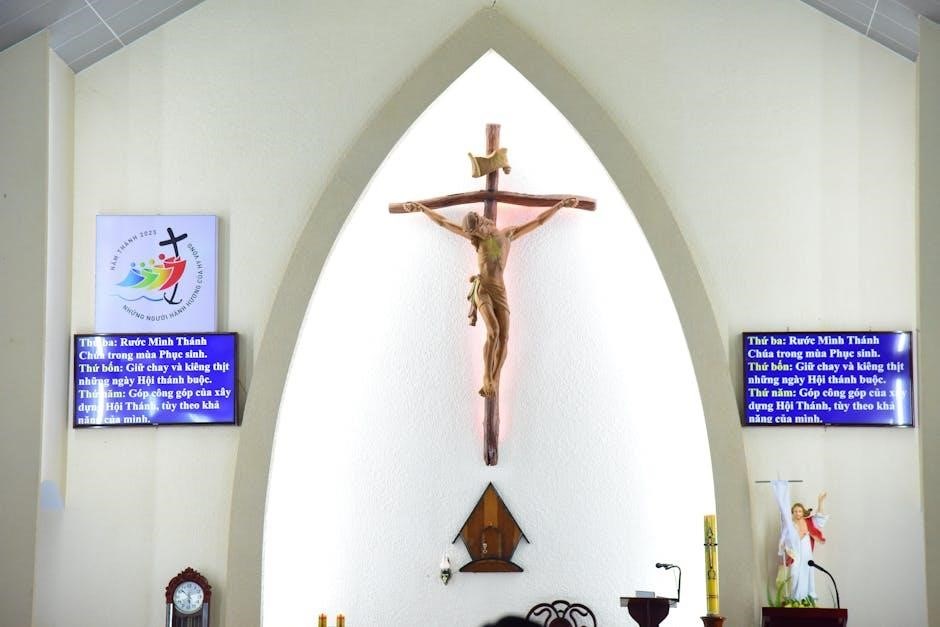
The last week of Jesus’ life, known as Passion Week, is a profound period marking His triumphal entry, teachings, crucifixion, and resurrection, fulfilling God’s plan for humanity.
Overview of the Last Week of Jesus’ Life
The last week of Jesus’ life, known as Passion Week, began with His arrival in Bethany and culminated in His resurrection. It includes His triumphal entry into Jerusalem, cleansing the temple, teachings, the Last Supper, crucifixion, and burial. Each day holds significant events that showcase His mission, humanity’s sin, and God’s redemptive plan. This week is central to Christianity, illustrating Jesus’ love, sacrifice, and victory over death, fulfilling biblical prophecies and securing salvation for humanity.

Saturday: Arrival in Bethany
Jesus Arrives at Bethany (John 12:1)
Jesus arrived in Bethany six days before the Passover, where He was anointed by Mary with costly perfume, an act of devotion that prepared Him for burial.
Jesus Arrives at Bethany (John 12:1)
Jesus arrived in Bethany six days before the Passover, where He was anointed by Mary with costly perfume, an act of devotion that prepared Him for burial.
The Supper Prepared for Him
In Bethany, a supper was prepared in Jesus’ honor, hosted by Lazarus, Martha, and Mary. Mary anointed Jesus’ feet with costly perfume, an act of worship and preparation for His burial. This intimate gathering highlighted the deep devotion of His followers and served as a moment of rest before the tumultuous events ahead. The supper symbolized the recognition of Jesus’ divine mission and the impending sacrifice He would undertake for humanity.

Sunday: Triumphal Entry into Jerusalem
Jesu’s triumphal entry into Jerusalem marked the beginning of Passion Week. Riding a donkey, He was greeted with palm branches and shouts of “Hosanna,” symbolizing His messiahship.
Triumphal Entry on a Donkey
Jesu’s entry into Jerusalem on a donkey symbolized humility and peace. The crowd waved palm branches, shouting “Hosanna,” acknowledging Him as the Messiah. This act fulfilled Zechariah’s prophecy, emphasizing His divine mission. The donkey, a symbol of servitude, contrasted with traditional royal entries on war horses, highlighting Jesus’ gentle and sacrificial nature, setting the stage for His redemptive work in the city.
Crowds Shout “Hosanna”
As Jesus entered Jerusalem, the crowd erupted in praise, shouting “Hosanna,” meaning “Save now;” They waved palm branches and laid cloaks on the ground, creating a triumphant pathway. This joyful reception marked Jesus as the long-awaited Messiah, fulfilling Old Testament prophecies. The atmosphere was electric with hope and anticipation, yet beneath the celebration lay tension, as religious leaders grew uneasy, foreseeing challenges to their authority and setting the stage for impending conflict.
Jesus Weeps Over Jerusalem
As Jesus approached Jerusalem, He wept over the city, lamenting its impending destruction. He foresaw the devastation that would come because the people failed to recognize God’s visitation. Jesus’ tears reflected His deep compassion for the city and its inhabitants, emphasizing His desire for their salvation. This moment highlights His prophetic insight and sorrow over spiritual blindness, underscoring the urgency of repentance and the consequences of rejecting God’s plan.
Monday: Cleansing the Temple
Monday marked significant events in Jesus’ final week, emphasizing His divine authority and judgment. He withered a fig tree, symbolizing spiritual barrenness, and cleansed the Temple again, overturning tables and condemning commerce in God’s house. The fig tree’s withering served as a visual lesson on faith and God’s power, while the Temple cleansing highlighted Jesus’ zeal for His Father’s house to be a place of true worship.
Withering the Fig Tree
On Monday morning, Jesus cursed a fig tree for its fruitlessness, symbolizing Israel’s spiritual barrenness. The tree withered immediately, astonishing the disciples. This act emphasized faith’s power and God’s judgment on hypocrisy, teaching that true spirituality must bear fruit. Jesus’ authority and divine judgment were evident, underscoring the need for genuine worship and obedience;
Second Cleansing of the Temple
On Monday, Jesus performed the Second Cleansing of the Temple, driving out merchants and money changers. He condemned their exploitation, declaring the Temple a house of prayer, not commerce. This bold act asserted His divine authority, provoking both awe and opposition. The incident highlighted His mission to restore worship and expose spiritual hypocrisy, resonating with the marginalized while angering religious leaders who sought to maintain their power and traditions.
Tuesday: Teaching and Conflict
Jesus spent Tuesday teaching in the Temple, confronting religious leaders who questioned His authority. This day marked escalating tensions and debates, foreshadowing the events leading to His arrest.
Jesus’ Last Day in the Temple
On Tuesday, Jesus delivered profound teachings in the Temple, engaging in intense debates with religious leaders. He shared parables, such as the one about the wicked tenants, which highlighted Israel’s spiritual failure. The authorities, angered by His claims, challenged His authority, leading to heightened tensions. This day marked Jesus’ final public teachings in the Temple, as the plot to arrest Him intensified, setting the stage for His eventual betrayal and arrest.
His Authority Challenged by the Sanhedrin
On Tuesday, the Sanhedrin questioned Jesus’ authority to teach and perform miracles. He responded with the parable of the wicked tenants, implying the leaders’ rejection of God’s messengers and challenging their spiritual leadership. This confrontation deepened their hostility, as they recognized His teachings as a direct critique of their actions and authority.
The Sanhedrin realized Jesus’ claims were divine, leading them to plot His arrest and death. This exchange highlighted the growing theological and political tensions between Jesus and the Jewish leadership, ultimately accelerating His journey to the cross.

Wednesday: Preparation and Controversy
Wednesday marked a day of preparation and rising tensions. Jesus addressed His disciples about His impending death while Gentiles sought Him. The Jews’ rejection of Christ intensified, as recorded in John 12:37-50, highlighting their hardened hearts despite His miracles and teachings.
This day also saw Jesus preparing for the events leading to His crucifixion, deepening His disciples’ understanding of His mission and the divine plan unfolding during Passion Week.
Day of Preparation
Wednesday was a day of preparation and growing tension. Gentiles sought Jesus, while the Jews’ rejection of Him intensified, as noted in John 12:37-50. This marked the beginning of the end of His public ministry, setting the stage for the crucifixion.
The events of this day were a precursor to the Passion, highlighting the divine plan unfolding. Jesus’ interactions emphasized the nearing fulfillment of His mission, preparing His disciples for the trials ahead.
Gentiles Seeking Jesus
During the Passion Week, Gentiles sought Jesus, indicating growing interest in His teachings beyond the Jewish community. This marked a significant shift, as His ministry began to transcend cultural boundaries, fulfilling God’s plan to reach all nations.
This event emphasized the universal appeal of Jesus’ message, even as the Jewish leaders’ rejection intensified. It highlighted the transition from focusing on Israel to embracing a broader, inclusive mission, preparing the way for the Gospel’s spread after His resurrection.
The Jews’ Rejection of Christ (John 12:37-50)
Despite Jesus’ miracles and teachings, many Jews refused to believe in Him, fulfilling Isaiah’s prophecy of spiritual blindness. Their rejection highlighted the deepened division between Jesus and the religious leaders, who saw Him as a threat to their authority. This chapter emphasizes the tragic outcome of unbelief, even in the face of divine revelation, underscoring the spiritual conflict central to Jesus’ final days in Jerusalem.

Thursday: The Last Supper
Jesus shared a final meal with His disciples, instituting the Eucharist, symbolizing His body and blood. This intimate gathering marked a pivotal moment of love, betrayal, and foretold denial.
Passion Week Timeline (Matthew 26:17-30, Mark 14:12-26, Luke 22:7-30, John 13:1-30)
The Passion Week timeline details the final days of Jesus’ life, from the preparation of the Passover to His departure for the Mount of Olives. On Thursday, Jesus instituted the Eucharist during the Last Supper, symbolizing His body and blood. He also predicted His betrayal and Peter’s denial. After Judas agreed to betray Him, Jesus and the disciples departed for Gethsemane, where His arrest would soon unfold, marking the beginning of His journey to the cross.
Christ’s Farewell Discourse
In the Upper Room, Jesus delivered His farewell discourse, comforting the disciples with promises of the Holy Spirit and eternal life. He emphasized trust in God and Himself, encouraging them not to be troubled. Jesus spoke of preparing a place for them and the unity of believers in God’s love. This discourse, recorded in John 14-17, was a heartfelt farewell, preparing the disciples for His departure and their future mission, while commanding them to love one another as He had loved them.
Friday: Crucifixion
Jesus was crucified at the 3rd hour (9:00 am) and gave up His spirit at the 9th hour (3:00 pm), fulfilling the sacrifice for humanity’s sins, offering redemption.
Crucifixion at the 3rd Hour (9:00 am)
Jesus was crucified at the 3rd hour, nailed to the cross at Golgotha, fulfilling the divine plan. This act of sacrifice symbolized His willingness to bear humanity’s sins, demonstrating unparalleled love and obedience to God’s will. The crucifixion marked the climax of His passion, embodying redemption and forgiveness for all mankind. This event is central to Christian theology, representing the ultimate sacrifice for the salvation of humanity.
Jesus Gives Up the Ghost at the 9th Hour (3:00 pm)
At the 9th hour, Jesus uttered His final words and gave up His spirit, marking the completion of His sacrifice. This moment coincided with the evening sacrifice, symbolizing His role as the ultimate atonement for humanity. The darkness that fell earlier mirrored the spiritual gravity of the event, as Christ bore the sins of the world. His death fulfilled ancient prophecies, bringing profound sorrow to His followers while securing eternal redemption for all. This act remains the cornerstone of Christian faith, embodying God’s boundless love and mercy.
Saturday: Burial
Jesus’ body was laid in the tomb, fulfilling the prophecy of three days and nights in the grave. His burial marked the culmination of His sacrifice.
Jesus in the Tomb for 72 Hours
Jesus’ body rested in the tomb for three days and nights, fulfilling the prophecy of Jonah. This period marked the transition from death to resurrection, symbolizing victory over sin. The tomb’s seal and guard ensured no tampering, while His followers mourned. This sacred time reaffirmed God’s promise of redemption, as the world awaited the miraculous resurrection on Sunday morning.

Sunday: Resurrection
Easter morning marked Jesus’ glorious resurrection, defeating death and sin. The empty tomb symbolized victory, fulfilling prophecies and bringing hope to humanity through eternal life.
Resurrection Celebration on Easter Morning
Easter morning brought unparalleled joy as Jesus rose from the tomb, triumphing over death. The empty tomb, discovered by women while still dark, became the cornerstone of Christian faith. This miraculous event fulfilled ancient prophecies, offering humanity redemption and eternal hope. Celebrations worldwide commemorate this day, symbolizing light overcoming darkness and life conquering death, forever altering history and the lives of believers.
Women Visit the Tomb While It Was Still Dark
On Easter morning, while it was still dark, women including Mary Magdalene and others arrived at Jesus’ tomb. They found the stone rolled away and the tomb empty, discovering the miraculous resurrection. This moment marked the fulfillment of Jesus’ promise to rise from the dead, bringing hope and joy to His followers. The women’s courage and devotion highlight their pivotal role in sharing the news of His resurrection, a cornerstone of Christian faith.
The Passion Week, from Jesus’ triumphal entry to His resurrection, underscores the fulfillment of God’s plan, offering redemption and hope through His crucifixion and victorious rise.
Significance of the Passion Week
The Passion Week is the most sacred period in Christianity, reflecting God’s profound love and redemption. It captures Jesus’ final teachings, crucifixion, and resurrection, symbolizing triumph over sin and death. This week embodies the core of Christian faith, offering hope and salvation through Jesus’ sacrifice. It reminds believers of God’s mercy and the eternal life promised through Christ’s resurrection, making it a cornerstone of spiritual reflection and celebration.